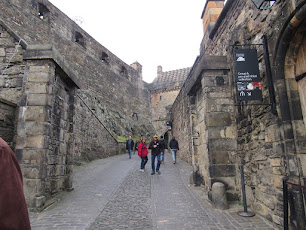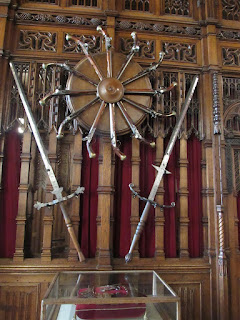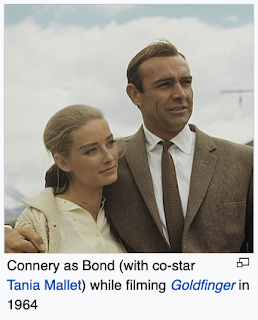
We spent a day in Edinburgh and found it to be an intriguing, vibrant city. One of the main attractions in the city is Edinburgh Castle, which is visible anywhere since it sits on top of a volcanic plug in the middle of the city.
Edinburgh Castle was built in the 12th century by King David I and served as a royal residence until 1633. By the 17th century it was used as a garrison and military barracks. It has been recognized as the national Scottish heritage place since the 19th century. As one of the most important strongholds in the Kingdom of Scotland, Edinburgh Castle was involved in many historical conflicts from the Wars of Scottish Independence in the 14th century to the Jacobite rising of 1745. Research in 2014 indicates that the castle has been "the most besieged place in Great Britain and one of the most attacked in the world".
 The castle houses the Scottish regalia, known as the Honours of Scotland, and is the site of the Scottish National War Memorial and the National War Museum of Scotland.
The castle houses the Scottish regalia, known as the Honours of Scotland, and is the site of the Scottish National War Memorial and the National War Museum of Scotland.
The castle entrance with posted guards. Below is a private bagpiper who plays for tourists in an area far from but leading up to the entrance.
Some other views of Edinburgh from the castle above it.
https://partyshopmaine.com/edinburg/why-are-bricks-in-edinburgh-black/


 Some decorative etching into a stone gate.
Some decorative etching into a stone gate.
The castle was built on volcanic rock. These close-up show how rock and castle are joined.
 The Great Hall was the chief place of state assembly in the castle. It measures 29 by 95 x 41 feet and is thought to have been completed in the early years of the 16th century under King James IV. It was converted into a
barracks for Oliver Cromwell's troops in 1650 and in 1737 it was subdivided into three
storeys to house 312 soldiers. It became a
military hospital from 1790 until 1897 and then was restored
in line with contemporary ideas of medieval architecture. The Great Hall is still occasionally used for ceremonial occasions.
The Great Hall was the chief place of state assembly in the castle. It measures 29 by 95 x 41 feet and is thought to have been completed in the early years of the 16th century under King James IV. It was converted into a
barracks for Oliver Cromwell's troops in 1650 and in 1737 it was subdivided into three
storeys to house 312 soldiers. It became a
military hospital from 1790 until 1897 and then was restored
in line with contemporary ideas of medieval architecture. The Great Hall is still occasionally used for ceremonial occasions.
Queen Elizabeth's presence is felt throughout the UK, including Edinburgh Castle.
Armor and Swords


St. Margaret's Chapel

St. Margaret's Chapel is the oldest of all the buildings. It was built in the 12th-century by King David I (r.1124–1153) as a private chapel for the royal family. He dedicated it to his mother, Saint Margaret of Scotland,
who died in the castle in 1093. It was used as a gunpowder store in the 16th century when the
present roof was built and restored in 1851–1852.The chapel is still used for religious ceremonies, such as weddings.
Prisons of War
The first prisoners were French privateers caught in 1758, soon after the Seven Years’ War began. Prisoners of war came from France, America, Spain, the Netherlands, Ireland, Italy, Denmark and Poland. Most were sailors, many of them Americans fighting in the War of Independence. Caribbean pirates were also held. In 1720, 21 members of Black Bart’s crew were captured off Argyll. They had come to Scotland to retire. Instead, most were hanged.
Click here to see the short video produced by the Edinburgh Castle.
Scottish National War Memorial


The somber ambience of the Scottish National War Memorial was like most: sheer sadness over the loss of the young generation who came of age at a time they were obliged to give their lives in war.
Over 147,000+ Scots died during the war (1914-19), which includes Scots who died in the trenches or at sea as well as nurses, about 500 munitions workers, the Merchant Navy, and many others.
The Memorial occupies a converted barrack block on the north side of Crown Square. Construction began in 1923 and opened in Edinburgh Castle in 1927. After World War II another 50,000 names were added to the Rolls of Honour.
One of the two sentries posted at the entrance of the Memorial.
Edinburgh Castle has become a recognizable symbol of Edinburgh, and of Scotland. Its stylized form appears on the coats of arms of the City of Edinburgh and the University of Edinburgh.


Famous Scots
Sir Walter Scott (1771-1832) was a Scottish novelist, poet, playwright and historian. His specialty was historical fiction. Many of his works remain classics of European and Scottish literature, notably the novels Ivanhoe, Rob Roy, Waverley, Old Mortality, The Heart of Mid-Lothian and The Bride of Lammermoor, and the narrative poems The Lady of the Lake and Marmion. He had a major impact on European and American literature.
Sir Arthur Ignatius Conan Doyle (1859-1930) was a Scottish writer and physician who created the character Sherlock Holmes in 1887 for A Study in Scarlet, the first of four novels and fifty-six short stories about Holmes and Dr. Watson. The Sherlock Holmes stories are milestones in the field of crime fiction.
Robert Louis Stevenson (1850-1894) was a novelist, essayist, poet and travel writer. He is best known for works such as Treasure Island, Strange Case of Dr Jekyll and Mr Hyde, Kidnapped, and A Child's Garden of Verses. He suffered from serious bronchial trouble for much of his life, but continued to write prolifically and travel widely in defiance of his poor health.He is also known for his pilgrimage through the Cévennes Mountains in south-central France and writing the book, Travels with a Donkey in the Cévennes, one of the first books to present hiking and camping as recreational activities.
Sean Connery (1930-2020) was the first actor to portray fictional British secret agent James Bond on film, starring in seven Bond films between 1962 and 1983. Bond's creator, Ian Fleming, originally doubted Connery's casting, saying that Connery (a muscular, 6' 2", and a Scot) was unrefined. Fleming's girlfriend Blanche Blackwell told him Connery had the requisite sexual charisma, and Fleming changed his mind after the successful Dr. No première.
He attended the Edinburgh Art College and worked as a milkman to pay for his tuition. Many people claim he was their milkman.
Greyfriars Bobby (1855-72) was a Skye Terrier who became known in 19th-century Edinburgh for spending 14 years guarding the grave of his owner, John Gray, until he died on 14 January 1872. Gray was a nightwatchman, and police were required to have dogs accompany them during duty.
The story continues to be well known in Scotland, through several books and films including one by Walt Disney (1961). This commemorative statue is a tourist attraction where they rub the polish off the dog's nose.
Resources
Scots who died in World War I -- https://www.bbc.com/news/uk-scotland-46124327
Edinburgh Castle -- https://en.wikipedia.org/wiki/Edinburgh_Castle


























No comments:
Post a Comment